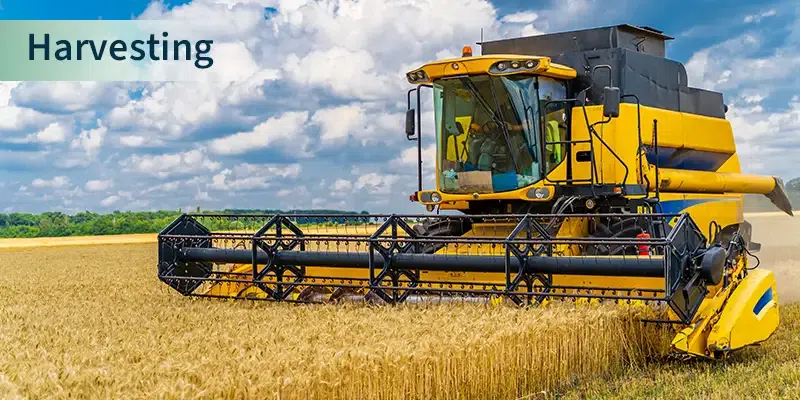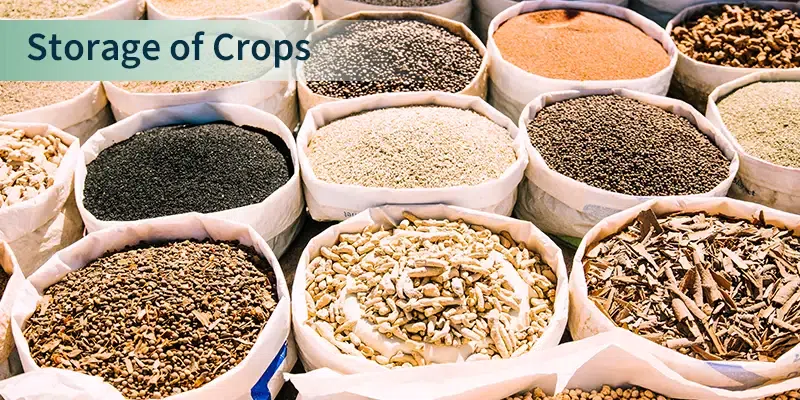Crop Production – Harvesting & Storage
Last Updated :
31 Dec, 2023
Crop production is an agricultural activity of cultivation of a crop on a large scale. Any plant grown on a large scale for food or income source is termed a crop. The increasing global population, coupled with escalating demands for food, crop production losses, and challenges in agricultural practices, causes a threat to food availability, particularly in certain regions. To reduce these problems crop management plays an important role. In addition to crop production, crop harvesting, and storage are also important for the long shelf life of the crop.
Crop Production Definition
Crop production is a widespread agricultural activity adopted by farmers globally to cultivate crops for both sustenance and fiber.
What is Crop Production?
Crop production involves various essential steps such as soil preparation, seed sowing, irrigation, and applying manure, pesticides, and fertilizers. Crop protection and harvesting are also important. The crop production involves the final stages of harvesting, a meticulous procedure requiring attention to detail, and subsequent storage to ensure the preservation of the produced crops.
Crop Harvesting
Harvesting involves the extraction of complete plants or economically valuable parts post-maturity, such as grain, seeds, leaves, roots, or the entire plant. The residual part of the stem left in the field after harvesting is referred to as stubble.

Methods of Crop Harvesting
There are two primary harvesting techniques in agriculture: mechanical and manual.
|
Use of
|
In the mechanical method, farmers use machinery.
|
In the manual method, farmers use labor.
|
|
Energy and cost
|
Low cost, time, and energy required method.
|
High cost and energy required time-consuming method.
|
|
Tools used
|
It involves using harvesters to gather mature crops.
|
It involves using tools like sickles.
|
|
Type of method
|
Advanced method
|
Traditional method.
|
Harvesting Methods of Different Crops
Leafy Vegetables
Typically, cabbage and lettuce heads are harvested by cutting them from the root at the base of the head, as close to the soil surface as possible, using a knife. When harvesting the fingers are positioned near the base of the petioles. By firmly holding onto the petiole, the leaf is removed from the plant, similar to the snap pick method used in tree fruit. This approach may result in the tearing of the petiole tissue. Use of knives is also an option for a cleaner cut.
Fruits
Fruits can be harvested using two methods:
- Snap Picking – Snap picking involves manually twisting the fruit off by hand. Snap picking is cautioned against exporting citrus fruit due to potential damage, but it may be suitable for non-export fruit.
- Clipping – Uses specialised pruning shears to cut the stem. It is generally preferred, ensuring a clean cut close to the calyx, reducing the risk of injuries and decay. Inefficient cutting can lead to long stems, causing problems during harvesting and storage.
Storage of Crops
Crop storage involves safeguarding economic products from undesired physical, chemical, and microbial alterations, playing a vital role in crop management.
Various traditional methods such as sun-drying, drums, use of camphor, etc. exists for crop storage.
- Pesticides are effective in preventing rodent infestations, while proper drying of grains in sunlight prevents fungal growth caused by a moist environment.
- Fumigation, involving the use of chemicals, serves as a method to prevent bacteria and microorganisms. Appropriate storage treatments include grain storage in gunny bags.

Crop management encompasses the entire crop production cycle, harvesting, as well as storage and distribution. Harvesting involves extracting entire plants or economically valuable parts post-maturity. Harvesting methods vary for different crops. Traditional crop storage methods involve sun drying and drum storage with hermetic sealing to prevent pests. Proper treatment ensures grains remain unaffected during extended storage periods.
FAQs on Crop Production and Harvesting
1. What is Crop Management?
Crop management involves the entire cycle of crop production, covering the phases of planting, nurturing, harvesting, as well as storage and distribution.
2. . What is in Crop Production?
Any plant or plant product cultivated on a large scale for the purpose of food or profit is termed a crop. Crop management involves the entire cycle of crop production, covering the phases of planting, nurturing, harvesting, as well as storage and distribution.
3. What are the Advantages of Crops?
The increasing global population demands for food, and significant threat to food availability, particularly in certain regions as well as commercial crop production for earning makes crop production necessary.
4. What are Traditional ways of Crop Storage?
The traditional crop storage methods includes sun-drying, drums, use of camphor, metal or plastic bags, etc.
5. What are the Types of Crop Production?
Crop production involves mainly two types: commercial and subsistence. Commercial crop production involves the cultivation of crops only for earning purposes. E.g.: Cotton. Subsistence crop production involves the cultivation of crops for food purposes. e.g: Vegetables, fruits, cereals.
Share your thoughts in the comments
Please Login to comment...